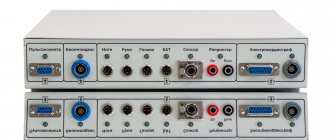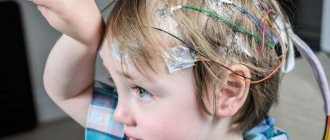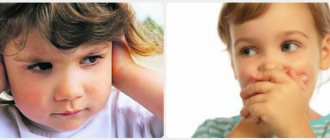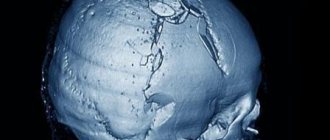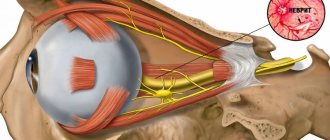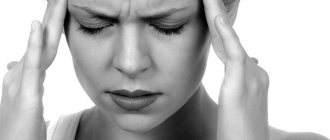Alalia is an insufficiency (deficiency) of speech that is not associated with somatic hearing or intellectual impairments. It occurs against the background of damage to the speech lobes of the brain during childbirth or in the prenatal period.
The most severe degrees of the disease are manifested by a complete lack of speech or incoherent babbling. A mild degree of impairment is characterized by difficulties in mastering writing and reading skills, a limited vocabulary and other deviations in the use of speech structures.
Causes and risk factors
Children with motor alalia are usually born with this pathology. The causes most often are various injuries and pathological processes that occur during the intrauterine development of the child. During pregnancy the following can cause harm:
- alcohol;
- sudden changes in hormonal levels;
- infections;
- falls and injuries;
- placental abruption;
- depression, constant stress.
Alalia can also cause problems in the first years of a child’s life. Brain damage is caused by:
- weak contractions and unsuccessful birth;
- breathing problems immediately after birth, due to which the brain does not receive enough nutrition;
- severe hypothermia of the newborn.
The disease can also develop after suffering from rubella, meningoencephalitis, severe head injuries and bruises, and due to somatic pathologies.
Clinical picture and behavioral characteristics of children
Children with motor alalia are distinguished by the following characteristics:
- Preserved intelligence. The child learns normally, understands gestures, recognizes pictures, and recognizes familiar people.
- Incorrect use of voice. Your baby may speak too loudly or too softly.
- Incorrect pronunciation of words and sentences (the child does not speak, but rather babbles), while voiced and soft consonants sound correctly.
- The baby does not respond to questions and finds it difficult to answer.
There is also a more severe form of alalia: with it, the child understands the address, but does not speak at all.
In addition to speech problems, a child may exhibit other typical symptoms, for example, children often experience fatigue, especially during learning. Excessive activity, interspersed with periods of fatigue, is common. Many children experience either severe inhibition or severe disinhibition, depending on the characteristics of the injury.
Important! Alalia does not occur due to stress or difficult life events. Its cause is brain damage, not fear or psychological trauma.
Alalia forms
There are several forms of motor alalia. It is customary to distinguish motor and sensory types of diseases. In the first case, the child cannot speak, in the second, he does not understand speech addressed to him. Sometimes vague symptoms occur, in which case doctors diagnose “mixed alalia.”
Alalia is brain damage that prevents a child from speaking.
Motor alalia
Motor (expressive) alalia is a disease in which the part of the child’s brain responsible for speech production is affected. It is located in the left hemisphere. During normal development, a newborn first assimilates non-speech noises: natural, technical, object. They are absorbed by the right hemisphere and become the basis for active speech development.
The task of the left hemisphere is to filter the signs of speech from the sounds collected by the right hemisphere. Non-speech sounds pass through the corpus callosum from one hemisphere to the other and are converted into speech sounds. This forms a speech base and allows the child to learn to speak. But children with motor alalia cannot modify non-speech sounds - they have damage to the part of the brain responsible for this function.
Depending on the severity of the damage, the baby can distinguish sounds and assimilate their semantic connections, but at the same time he is unable to form articulatory movements. If the damage to the cerebral cortex and left hemisphere is not severe and the motor areas are preserved, this ability can be restored.
Depending on the location of the problems, motor alalia can take two forms:
- efferent. Occurs when the premotor cortex is damaged (posterior third of the inferior frontal gyrus, Broca's area). Because of it, the child becomes unable to form a series of movements: he pronounces a single sound, but cannot say a group of sounds. Symptom: distortion of the syllabic structure of a word, getting stuck on one syllable;
- afferent. Occurs when the postcentral zone of the cerebral cortex (lower parietal part of the left hemisphere) is damaged. It causes a disorder in the senses of articulatory posture: the child does not understand whether his mouth is open or closed, what position his tongue and lips are in, or whether there is vibration of the vocal cords. This leads to incorrect pronunciation of some sounds. Also, the baby avoids saying sounds that are too complex in terms of articulation, so he often skips or replaces them with others.
Both types of motor alalia are treated with a set of measures that include both drug therapy and speech therapy sessions.
Symptoms of motor alalia
The symptoms of motor alalia are:
- complete absence of speech after 3 years of life (before this, doctors diagnose “delayed speech development”);
- neurological symptoms: fatigue, unilateral ptosis of the eyelid, shifting pupils, disorder of finger motor skills, difficulty identifying parts, numbers, sides (left-right);
- psychopathological symptoms: deviations in auditory attention, concrete thinking, weakness of attention, underdevelopment of the emotional and volitional sphere, mood lability, excessive gullibility or severe irritability;
- poor posture and asthenicity, problems with coordination of movements, left-handedness due to weakness of the right hand, hyperactivity or immobility;
- speech signs: impaired pronunciation of all groups of sounds, inability to correctly pronounce words, phrases, incorrect use of pitch and strength of voice, impoverished vocabulary, gross violations of grammar (infinitives are especially often used instead of verb forms);
- the discrepancy between active and passive vocabulary is a very clear symptom. The child understands the word and is able to interpret its meaning, but cannot pronounce it.
Early diagnosis of this disease allows you to start treatment on time and make it more effective. If you notice one or more symptoms, do not delay visiting your doctor.
Diagnosis and treatment of motor alalia
With motor alalia, much attention is paid to diagnosis. The problem is that this disease can be easily confused with other speech disorders. The examination should include:
- taking anamnesis, if possible. It allows you to determine the causes of pathology;
- completing various studies. Often prescribed: EEG, echoencephalography, auditory function testing - otoscopy, audiometry; X-ray of the skull, MRI of the brain;
- consultations with an ENT specialist, psychoneurologist, neurologist, psychologist;
- dynamic examination, which begins after correctional work: a specialist looks at the dynamics of speech development and clarifies the diagnosis.
Children with motor alalia must be treated using several methods at once. With the right approach, you can return a child to normal speech in 2-3 years. To do this you need:
- Take medications such as Piracetam, Nootropil, Pantogam, Cerebrolysin, Actovegil, etc.
- Visit a physiotherapy office. Electrophoresis, magnetic and laser therapy, IRT, hydrotherapy, and electropuncture are often prescribed.
- Work with fine motor skills, develop memory and thinking.
- Form a vocabulary, engage in logorhythmic exercises, stimulate speech activity.
It is very important to choose the right drugs based on the degree of brain damage. Also, treatment should be carried out by an experienced speech therapist who is already familiar with the problem and knows how to work with it. Avoid traditional methods: they are ineffective and simply waste your time.
Possible complications and consequences
If time is wasted and children with motor alalia are not treated, they may have significant problems in the future. The most common consequences:
- the appearance of dysgraphia and dyslexia, when a child cannot write or perceive written text correctly;
- the occurrence of stuttering and other disturbances in the functioning of the articulatory apparatus;
- the appearance and strengthening of speech negativism (conscious refusal to speak when the child does not want to use words at all).
Complications significantly complicate the child's integration into society and reduce his learning opportunities.
Speech negativism can be a consequence of other factors. For example, diction is impaired by crooked teeth. Read more about this here: Causes, dangers and treatment of crooked teeth in children and adults.
Forecast
The prognosis and improvements observed during treatment of children with motor alalia depend very much on the degree of damage to brain structures. In many ways, our body is able to compensate for some violations, but this is impossible with extensive lesions. The age at which treatment began also influences, since the older the person, the less likely it is to restore speech function.
The disease has a favorable prognosis: after 2-3 years of regular classes, the child will reach the language norm, compensate for the impairments and get rid of most symptoms.
Prevention
Prevention of alalia must begin during pregnancy. During this period, it is necessary to avoid factors that can damage the speech centers in the child’s brain or cause their insufficient development. You should also not give up breastfeeding without good reasons, conduct regular examinations of the baby and engage in the comprehensive development of the child.
There is no panacea, no magic method that is guaranteed to save you from the development of motor alalia. But the right approach to bearing and raising a baby will help simplify diagnosis at the beginning of life and make subsequent treatment more effective.
Sensory alalia
Sensory alalia is a consequence of damage to the cortical end of the auditory-speech analyzer (Wernicke's center) and its pathways. Because of this damage, the child “does not hear” the words of others, despite good hearing and the ability to develop active speech. The child’s own speech is completely absent, and if it develops, it stops at the level of babbling words. The baby can repeat the word he just heard and remember it for a while. The lack of ability to recognize sounds leads to the fact that the child does not understand speech at all.
Diagnostic methods and symptoms
Diagnosis is carried out using the same methods as for children with motor alalia: the child needs to undergo an EEG, skull X-ray, MRI of the brain, otoscopy, etc. To clarify the diagnosis, you should visit a neurologist, speech therapist, psychologist, otolaryngologist.
The diagnosis is made when several of the following symptoms are observed at once:
- speech is active, children “talk” a lot and with normal intonations, but at the same time the phrases are incomprehensible to others because they consist of fragments of words and meaningless sound combinations;
- connections between heard and spoken words are not formed, the names of objects are not assigned to them;
- the child remembers the word after 20-25 repetitions, compared with the normal 3-5 for a healthy child;
- there is a lack of control over one’s own speech;
- neurological and mental symptoms manifest themselves in increased excitability, weak manifestations of the emotional-volitional sphere and secondary mental retardation.
Often children with sensory alalia exhibit non-standard hearing function. They hear any sounds well, but quickly get tired of them, so they may stop perceiving loud sounds (exhaustion of auditory function). A child can perceive effects of the same frequency and volume in different ways: sometimes he hears them, sometimes he doesn’t hear them. The greater the interval between sounds/words, the better the child recognizes them.
Corrective work of a speech therapist
It is important to understand that the main task of a speech therapist when working with alalik is to turn on the preserved channels of speech activity and make them work actively. There are many techniques for this, which only a specialist can apply correctly. Parents cannot replace a speech therapist.
Classes with a speech therapist for alalia are very important
Treatment options
Sensory alalia is most often treated primarily with medication. But this is not entirely the right approach: a complex influence is needed. The stages of treatment are as follows:
- Selection of drugs. They are needed to improve cerebral circulation and correct behavior (if the child is too passive or too active). It is possible to replace the effects of the pills with traditional Chinese medicine, but this requires a trip to China. In Russia, such treatment is offered mainly by charlatans.
- Working with a psychologist. Moreover, it is needed not only by the child, but also by the family. It is very important to properly build communication between all people involved in treatment.
- Working with a speech therapist. The speech therapist is the main specialist who confirms the diagnosis and begins treatment. It is very important to find a good doctor.
- Finding motivation. Classes are difficult for most children, so it is important that the family supports the child’s success.
- Forming the habit of studying at home. It is important that parents come to understand that treatment does not end at the speech therapist’s office. At home, you need to create conditions for classes, purchase or borrow teaching materials, learn how to use them correctly, and ask your speech therapist for homework. Creative activities for the development of fine motor skills are also important: drawing, modeling, etc. It is possible to connect additional non-standard techniques: hippotherapy, dolphin therapy, etc.
- Overcoming speech negativism and creating the right language environment.
- Development of motor skills through active games, music, dancing, logarithmic activities.
The more options for treatment activities you include and the better conditions you create, the greater the chance of coping with the disease.
Massage technique
Often, with alalia, it is recommended to do a special speech therapy massage. It is necessary not for the development of articulation organs, but so that the child begins to feel them better. But often massage is not required at all: speech impairment is often caused not by problems with the articulatory apparatus, but by other factors.
You cannot perform a massage on your own: it must be done by a specialist who has undergone special training and knows the specifics of working with patients. Massage is also contraindicated in cases of enlarged lymph nodes, viral or bacterial diseases of the oral cavity, blood and vascular diseases, and in some other cases.
Silence mode when correcting sensory alalia
There is a special technique that helps increase a child’s sensitivity to sounds. It consists in creating certain living conditions. The speech therapist recommends that parents organize a quiet hour and a day of hearing rest with some regularity. In the children's room, unnecessary sounds are eliminated for this purpose: TV, computer, tablet. Also, during this time, adults should not talk to the child.
The silence mode is interspersed with the interest mode. The child stops running away from annoying sounds and begins to study them. The speech therapist helps the child identify the subject of sound and recognize speech. The specialist also draws the child’s attention to various emotional reactions, helps them copy and express them if necessary.
Prognosis and prevention
Although motor alalia has a more favorable prognosis, parents of children with the sensory form should not give up. Here, too, the degree of brain damage has a strong influence. Be sure to go through all possible diagnostic options and select medications that help the body compensate for lost functions.
Corrective work of a speech therapist
All corrective work must be carried out consistently and comprehensively. Treatment is carried out in several stages of a certain sequence.
Stage one
Training in distracting noises not related to speech. This may be the sound of a bell, rattles or other objects. Sounds must have different tonality, timbre, and volume.
Stage two
Teaching individual letters and sounds. The baby must learn to understand and pronounce simple sounds consisting of individual letters, for example, “rrrrrr”.
Stage three
Learning to pronounce syllables, simple words.
Stage four
Learn to pronounce words. There is training in composing simple word combinations and phrases.
Stage five
Increasing active and passive reserve, complication of speech patterns.
Conclusions. Expert advice
Children with motor alalia have a chance for a normal life if their parents did not let everything take its course. The disease can be identified at the age of 3 years, when the problem is completely correctable. First of all, it is necessary to make a diagnosis and confirm it with several doctors. So, an audiologist should give his opinion, because alalia is in many ways similar to ordinary deafness.
Treatment of the disease must be comprehensive. During diagnosis, its cause is determined and a course is prescribed. Afterwards, the child must be given medications, attend a physiotherapy room, classes on general manual motor skills, etc. Stimulating speech activity with a speech therapist plays a significant role.
Remember that the prognosis for alalia, although it depends on the degree of brain damage, is determined by proper treatment. Timely identification of the problem and the use of all available methods of therapy can often completely eliminate motor alalia and significantly reduce the impact of sensory alalia on the child’s life.
Treatment
Treatment of alalia requires an integrated approach. The first thing that needs to be done is to accurately confirm the diagnosis with a speech neurologist. If neurological disorders correspond and are confirmed by a number of functional studies, the purpose of which is to assess the conductivity of the auditory nerves, the patient is prescribed drug therapy.
The work of speech neurologists at our center is based on expert therapeutic protocols; they prescribe medications to children with great care, trying to choose those medications whose use will not lead to unpleasant side effects.
Simultaneously with taking medications, an individual correctional route is built for each little patient; this activity is carried out by the department of therapeutic pedagogy of the center. Treatment of alalia requires the mandatory participation of a neuropsychologist and speech therapist-rehabilitation specialist in the process.
Also, to increase the therapeutic effect, the center uses the standard of neurorehabilitation used in Europe. This non-invasive therapeutic method helps restore nerve connections in the patient’s cerebral cortex.
